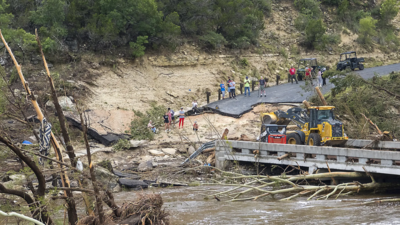
Crews work to clear debris from the Cade Loop bridge along the Guadalupe River on Saturday, July 5, 2025, in Ingram, Texas. (Pic credit: AP)
As central Texas mourns the deaths of more than 100 people killed in devastating flash floods over the fourth of July weekend, Kerr County is under a harsh spotlight for its failure to act, not just during the storm, but in the years leading up to it.A CNN investigation has revealed that despite repeated warnings and acknowledged flood risk, Kerr County lacked even the most basic emergency alert infrastructure, including flood warning sirens. When the Guadalupe River surged 30 feet in just hours on July 4, no county-wide evacuations were ordered, and internal National Weather Service (NWS) communications show no interaction from Kerr County officials with federal meteorologists, even as neighbouring counties coordinated frantically in real-time.The result: a tragedy many experts say was avoidable.A deadly silenceThe National Weather Service issued its first public flash flood alert at 1.14 am, warning of “life-threatening flash flooding of creeks and streams.” Several increasingly urgent warnings followed, including one at 4.03 am urging people to “move to higher ground now.”But in parts of rural Kerr County, cellphone coverage was spotty, and without sirens, many people didn’t receive the alerts, especially at Camp Mystic, where at least 27 campers and staff were killed.
Behind the scenes, NWS staff were communicating with local emergency officials across the region via a real-time internal messaging platform. Emergency managers from other counties were engaged and asking questions. Kerr County, however, was silent.Decades of inactionThe tragedy highlights what many experts call a systemic failure of local preparedness.In 2016, then-County Commissioner Tom Moser publicly warned that Kerr County was “probably the highest risk area in the state for flooding.”
He called its warning system “marginal at best.”Yet:
- A 2017 FEMA grant request for $980,000 to build a siren system was denied.
- In 2021, commissioners discussed setting aside $50,000 for a basic warning system, but it went nowhere.
- In 2023, the county declined to apply for a Texas infrastructure grant because it would only cover 5% of the cost.
According to Moser, proposals to install sirens often got bogged down in politics and public resistance. “Some people didn’t like the concept of sirens going off and disturbing everybody,” he told CNN.At a 2016 meeting, fellow commissioner H A “Buster” Baldwin even joked, “The thought of our beautiful Kerr County having these damn sirens going off in the middle of the night, I’m going to have to start drinking again to put up with y’all.”Baldwin died in 2022. The sirens were never installed.The price of delayIn neighbouring Comfort, Texas, downstream from the Guadalupe, two flood sirens helped prompt timely evacuations. No deaths have been reported there so far. The topography and timing were different, experts say, but sirens likely helped save lives.“There should have been a better system,” said Philip Bedient, a flood modelling expert from Rice University.
“What happened in Kerr County was inexcusable.”Mark Rose, former river authority manager, added: “We’ll spend more on recovery than the several million it would’ve cost to put in a system of gauges.”The Upper Guadalupe River Authority has just five gauges monitoring river conditions in Kerr County—not nearly enough, experts say.A deafening lack of responseWhen CNN reached out to Kerr County Emergency Management Coordinator W B “Dub” Thomas, he replied: “I don’t have time for an interview, so I’m going to cancel this call.”Officials have since defended the lack of evacuation orders, citing fears of putting people at risk while trying to evacuate during a flash flood. “Evacuation is a delicate balance,” said Kerrville City Manager Dalton Rice, who warned against crying wolf.But survivors and critics argue the county failed to strike any balance at all.“You know, cell phones are good,” Moser said. “Text messages are good. But there are places in the Hill Country where you can’t get a signal. That’s where sirens save lives.”

 3 hours ago
37
3 hours ago
37




























 English (US)
English (US)